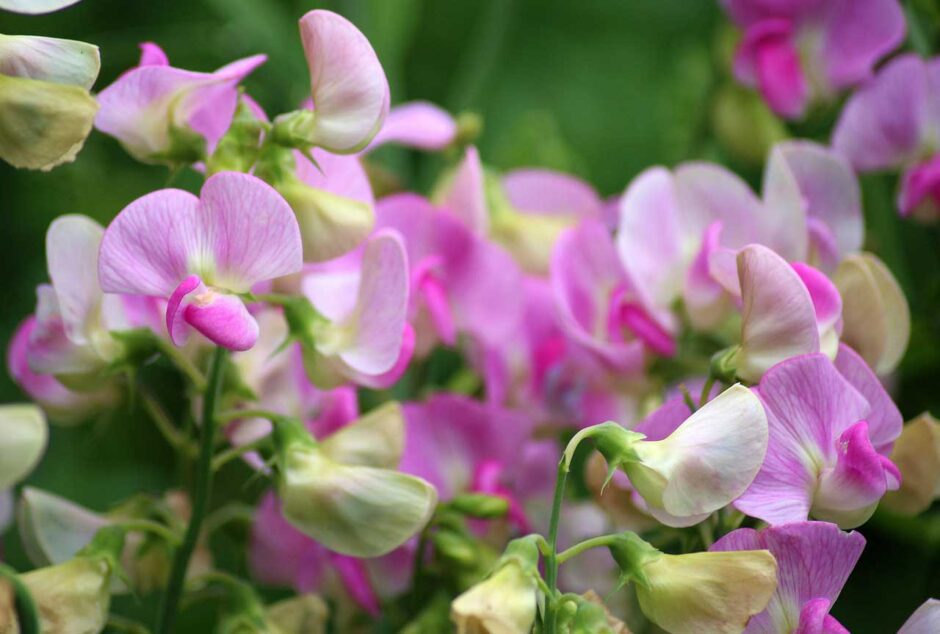
Key Takeaways for Growing Sweet Peas Successfully
- Start Early for Stronger Plants
- Sow seeds in autumn (Oct-Nov) for robust growth and more flowers, or in spring (Mar-May) for smaller displays. Use deep pots or cardboard toilet rolls to encourage deep roots.
- Slugs Love Sweet Peas—Fight Back!
- Protect young plants with organic aluminium sulphate pellets and nightly slug patrols (gloves/trowel advised!).
- Pinch for Bushiness
- When seedlings hit 10cm tall, pinch off the top 10cm to boost side shoots and prevent weak stems.
- Prep Soil Like a Pro
- Dig 12-inch holes, line with newspaper, and backfill with compost/manure for optimal drainage and moisture retention.
- Feed for Fabulous Flowers
- Use tomato feed or homemade comfrey fertilizer once flowers form (every 2-3 weeks). Avoid feeding seedlings.
- Water Wisely
- Water in the morning to let foliage dry, reducing flower drop. Mulch with compost to block soil pathogens.
- Support Systems Matter
- Secure plants to wigwams, trellises, or obelisks with garden twine. Even self-clinging varieties benefit from gentle tying.
- Pick Often, Bloom More
- Regularly deadhead or cut flowers for bouquets—this triggers new blooms and fills your home with fragrance.
- Container-Friendly Varieties
- Grow compact types like ‘Pink Cupid’ or hanging basket star ‘Pea Sugar n Spice’ for small-space displays.
- Troubleshoot No Flowers
- Ensure consistent feeding, check support grips, and cut back sparse blooms to stimulate growth.
Pro Tip: Autumn-sown sweet peas often outshine spring-planted ones—give them a try for a show-stopping summer!
Growing Sweet Peas from Seed
Sowing Sweet peas are easy and a good project for growing sweet peas with children to try out. The best time to get planting from seed is during October and November for a big head-start, or March to May for a smaller display. When growing sweet peas, sow 2 seeds, 1 cm deep into moist seed compost in pots and keep them in a warm(ish) spot, away from draughts and frosts. Cover with newspaper until germination takes place. Check every day!
Allow between 10-20 days for Sweet pea germination. When the seedlings appear, move your plants to a brighter spot and keep them at around 5 degrees C for the best results in growing sweet peas.
Do slugs eat Sweet peas?
The answer to that question is “Yes!” Slugs do eat Sweet peas, especially when the plants are young and tender. Protect the young plants from birds, mice, rats and slugs/snails. Growing your Sweet pea seeds in autumn produces better plants with more flowers.
Sweet peas, as with other legumes, prefer to be planted in deep pots to allow the roots to descend. You might want to try growing them in cardboard toilet rolls for a good start in life.
Why Autumn Planting Boosts Growth
Growing sweet peas from seeds in autumn yields stronger plants with more flowers. Start seeds in deep pots or cardboard toilet rolls to encourage deep root growth—key for healthy climbers.
Pinching Out Sweet Peas
When growing sweet peas, pinch out the top 10cm of stems once seedlings reach 10cm tall. This stimulates side shoots and prevents weak, curly stems. Strong stems = more flowers!
Planting Sweet Peas: Timing & Soil Prep
Plant out between April and June. Prepare soil by mixing in well-rotted manure or compost. For optimal drainage, dig a 12-inch hole, line with newspaper, and backfill. Space plants 7-10cm apart near supports (canes, trellis).
Protecting Growing Sweet Peas from Slugs
Slugs devour young plants. Use organic aluminium sulphate pellets and nightly patrols (gloves/trowel recommended!). Mulch with compost to block soil pathogens and retain moisture.
Prepare the soil before planting
Before planting Sweet peas, prepare the soil by adding plenty of well-rotted manure or compost and working it in. It is important to have free draining soil, but at the same time, moist areas for the root to reach down to. For this reason, I like to dig a hole about 12 inches deep and line it was newspapers. I then backfill it with soil/manure, ready to plant your climbers.
Place each Sweet pea plant in holes that are 5-8 cm from the cane/stick or trellis. Each plant should be 7-10 cm apart. Then, as always, water well.
How to Grow Sweet Peas On After Planting
Keep on picking the dead-heads to encourage more flower development. Consider making a habit of cutting Sweet peas and taking them into the house to use as a natural air freshener. In this way, new flowers will soon replace the ones. The more you pick, the more you get!
Be vigilant. Young Sweet pea plants provide tasty snacks to slugs and snails. Because of this, I recommend using organic aluminium sulphate-based slug pellets. Never use non-organic slug pellets! Also, as an extra level of protection, check your peas before bed. With torch in hand (or on the head), pick out any slugs and do with them whatever your conscience allows. Because they are so slimy, I recommend that slugs are better handled with gloves or a trusty trowel. By doing this each night, your Sweet peas should be pest-free. You will be amazed at how effective these two approaches are.
Mulching & Watering your Sweet Peas
I would also recommend mulching your Sweet pea plants with compost. As a result, this will prevent pathogens in the soil from being transferred to the leaves and flowers during rainfall.
Water your Sweet pea plants in the morning, to allow the foliage and flowers time to dry out during the day. This will help to prevent flower drops, should the temperature suddenly drop during the day.
Sweet Pea Support
Most varieties of Sweet peas will produce tendrils that will attach to any support you give them. However, some varieties aren’t as good at latching on. In this case, you will need to tie such types. I tend to tie all varieties to be on the safe side. Doing so will prevent them from being thrown around in the wind and will result in stronger plants. Tie with flexible or loosely arranged garden twine. Don’t strangle them!
Different types of support
You could try growing Sweet peas up an obelisk, or against a trellis. Many people prefer to let them ramble into a wigwam made of canes or sticks.
If you are making a wigwam, consider winding garden twine around the entire base of the wigwam, reaching the top. This will give excellent support for your Sweet peas as they grow upward. If you do so, you will be delighted by strong blooms all summer.
Growing Sweet Peas in Containers
Growing Sweet peas in pots is not as silly as it sounds. Some varieties are happy growing in containers, such as ‘Pink Cupid‘ or ‘Duvet Mix‘. One variety does well in hanging baskets. ‘Pea Sugar n Spice‘ is a sturdy plant. It becomes smothered in flowers and will look great in any hanging basket.
What to feed Sweet Peas for more growth
If your soil is poor and generally unproductive, I suggest using a high potash-based fertiliser for the best results. Tomato food is a very good option and readily available. If you make your own comfrey feed, then use it. Sweet peas love a comfrey feed. Don’t feed them when they are seedlings. Feed your plants as soon as the flowers start to develop. Repeat every 2 or 3 weeks.
Why Are my Sweet peas not flowering?
Make sure you are feeding your Sweet peas every couple of weeks. Check to see if they can grip onto the supports you have provided. If the flower supply is just low, then consider cutting what you have to encourage more new growth.
For more information on growing and care for Sweet peas, please visit the Gardener’s World website. You can also read an article I wrote on the topic of highly scented flowers.
I hope you have enjoyed reading this article. Please don’t forget to share this tutorial on social media and with your friends. Doing so will help support my website and allow me to write even more articles in the future. All the best to you and your garden!



